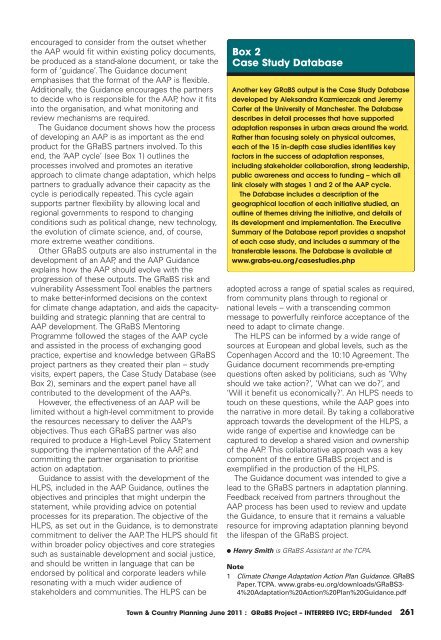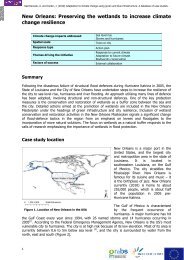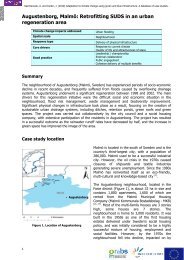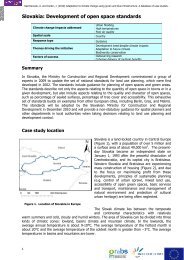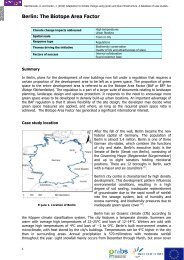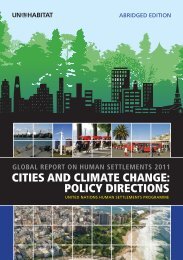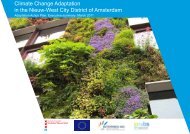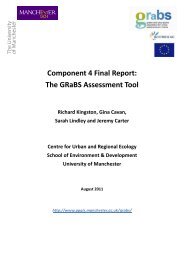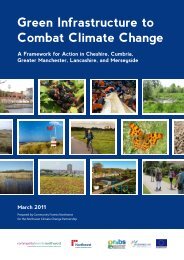Download - GRaBS
Download - GRaBS
Download - GRaBS
Create successful ePaper yourself
Turn your PDF publications into a flip-book with our unique Google optimized e-Paper software.
encouraged to consider from the outset whether<br />
the AAP would fit within existing policy documents,<br />
be produced as a stand-alone document, or take the<br />
form of ‘guidance’. The Guidance document<br />
emphasises that the format of the AAP is flexible.<br />
Additionally, the Guidance encourages the partners<br />
to decide who is responsible for the AAP, how it fits<br />
into the organisation, and what monitoring and<br />
review mechanisms are required.<br />
The Guidance document shows how the process<br />
of developing an AAP is as important as the end<br />
product for the <strong>GRaBS</strong> partners involved. To this<br />
end, the ‘AAP cycle’ (see Box 1) outlines the<br />
processes involved and promotes an iterative<br />
approach to climate change adaptation, which helps<br />
partners to gradually advance their capacity as the<br />
cycle is periodically repeated. This cycle again<br />
supports partner flexibility by allowing local and<br />
regional governments to respond to changing<br />
conditions such as political change, new technology,<br />
the evolution of climate science, and, of course,<br />
more extreme weather conditions.<br />
Other <strong>GRaBS</strong> outputs are also instrumental in the<br />
development of an AAP, and the AAP Guidance<br />
explains how the AAP should evolve with the<br />
progression of these outputs. The <strong>GRaBS</strong> risk and<br />
vulnerability Assessment Tool enables the partners<br />
to make better-informed decisions on the context<br />
for climate change adaptation, and aids the capacitybuilding<br />
and strategic planning that are central to<br />
AAP development. The <strong>GRaBS</strong> Mentoring<br />
Programme followed the stages of the AAP cycle<br />
and assisted in the process of exchanging good<br />
practice, expertise and knowledge between <strong>GRaBS</strong><br />
project partners as they created their plan – study<br />
visits, expert papers, the Case Study Database (see<br />
Box 2), seminars and the expert panel have all<br />
contributed to the development of the AAPs.<br />
However, the effectiveness of an AAP will be<br />
limited without a high-level commitment to provide<br />
the resources necessary to deliver the AAP’s<br />
objectives. Thus each <strong>GRaBS</strong> partner was also<br />
required to produce a High-Level Policy Statement<br />
supporting the implementation of the AAP, and<br />
committing the partner organisation to prioritise<br />
action on adaptation.<br />
Guidance to assist with the development of the<br />
HLPS, included in the AAP Guidance, outlines the<br />
objectives and principles that might underpin the<br />
statement, while providing advice on potential<br />
processes for its preparation. The objective of the<br />
HLPS, as set out in the Guidance, is to demonstrate<br />
commitment to deliver the AAP. The HLPS should fit<br />
within broader policy objectives and core strategies<br />
such as sustainable development and social justice,<br />
and should be written in language that can be<br />
endorsed by political and corporate leaders while<br />
resonating with a much wider audience of<br />
stakeholders and communities. The HLPS can be<br />
Box 2<br />
Case Study Database<br />
Another key <strong>GRaBS</strong> output is the Case Study Database<br />
developed by Aleksandra Kazmierczak and Jeremy<br />
Carter at the University of Manchester. The Database<br />
describes in detail processes that have supported<br />
adaptation responses in urban areas around the world.<br />
Rather than focusing solely on physical outcomes,<br />
each of the 15 in-depth case studies identifies key<br />
factors in the success of adaptation responses,<br />
including stakeholder collaboration, strong leadership,<br />
public awareness and access to funding – which all<br />
link closely with stages 1 and 2 of the AAP cycle.<br />
The Database includes a description of the<br />
geographical location of each initiative studied, an<br />
outline of themes driving the initiative, and details of<br />
its development and implementation. The Executive<br />
Summary of the Database report provides a snapshot<br />
of each case study, and includes a summary of the<br />
transferable lessons. The Database is available at<br />
www.grabs-eu.org/casestudies.php<br />
adopted across a range of spatial scales as required,<br />
from community plans through to regional or<br />
national levels – with a transcending common<br />
message to powerfully reinforce acceptance of the<br />
need to adapt to climate change.<br />
The HLPS can be informed by a wide range of<br />
sources at European and global levels, such as the<br />
Copenhagen Accord and the 10:10 Agreement. The<br />
Guidance document recommends pre-empting<br />
questions often asked by politicians, such as ‘Why<br />
should we take action?’, ‘What can we do?’, and<br />
‘Will it benefit us economically?’. An HLPS needs to<br />
touch on these questions, while the AAP goes into<br />
the narrative in more detail. By taking a collaborative<br />
approach towards the development of the HLPS, a<br />
wide range of expertise and knowledge can be<br />
captured to develop a shared vision and ownership<br />
of the AAP. This collaborative approach was a key<br />
component of the entire <strong>GRaBS</strong> project and is<br />
exemplified in the production of the HLPS.<br />
The Guidance document was intended to give a<br />
lead to the <strong>GRaBS</strong> partners in adaptation planning.<br />
Feedback received from partners throughout the<br />
AAP process has been used to review and update<br />
the Guidance, to ensure that it remains a valuable<br />
resource for improving adaptation planning beyond<br />
the lifespan of the <strong>GRaBS</strong> project.<br />
● Henry Smith is <strong>GRaBS</strong> Assistant at the TCPA.<br />
Note<br />
1 Climate Change Adaptation Action Plan Guidance. <strong>GRaBS</strong><br />
Paper. TCPA. www.grabs-eu.org/downloads/<strong>GRaBS</strong>3-<br />
4%20Adaptation%20Action%20Plan%20Guidance.pdf<br />
Town & Country Planning June 2011 : <strong>GRaBS</strong> Project – INTERREG IVC; ERDF-funded 261


